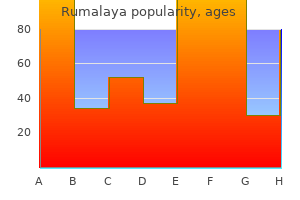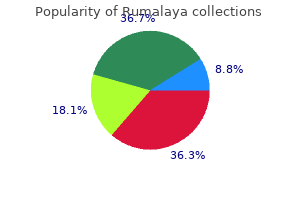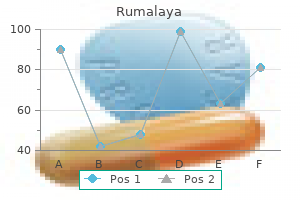

 5100 Springfield St. Suite 108, Dayton, Ohio 45431-1274
5100 Springfield St. Suite 108, Dayton, Ohio 45431-1274Rumalaya
"Rumalaya 60 pills on-line, symptoms to diagnosis".
By: I. Vibald, MD
Medical Instructor, University of Connecticut School of Medicine
Narrowing and drop-out of small airways precede the onset of emphysematous destruction medicine quotes buy rumalaya 60pills low price. Their walls become perforated and later obliterated with coalescence of small distinct air spaces into abnormal and much larger air spaces medicine joji buy rumalaya canada. Macrophages accumulate in respiratory bronchioles of essentially all young smokers medicine januvia buy generic rumalaya 60 pills on line. Bronchoalveolar lavage fluid from such individuals contains roughly five times as many macrophages as lavage from nonsmokers. Emphysema is classified into distinct pathologic types, the most important being centriacinar and panacinar. Centriacinar emphysema, the type most frequently associated with cigarette smoking, is characterized by enlarged air spaces found (initially) in association with respiratory bronchioles. Centriacinar emphysema is usually most prominent in the upper lobes and superior segments of lower lobes and is often quite focal. Panacinar emphysema refers to abnormally large air spaces evenly distributed within and across acinar units. Increases in the residual volume and the residual volume/total lung capacity ratio, nonuniform distribution of ventilation, and ventilation-perfusion mismatching also occur. Asthma patients can also develop chronic (not fully reversible) airflow obstruction. Airflow during forced exhalation is the result of the balance between the elastic recoil of the lungs promoting flow and the resistance of the airways limiting flow. Changes in large airways cause cough and sputum, while changes in small airways and alveoli are responsible for physiologic alterations. Goblet cells not only increase in number but in extent through the bronchial tree. Bronchi also undergo squamous metaplasia, predisposing to carcinogenesis and disrupting mucociliary clearance. In more advanced disease, the entire curve has decreased expiratory flow compared to normal. Hyperinflation of the thorax during tidal breathing preserves maximum expiratory airflow, because as lung volume increases, elastic recoil pressure increases, and airways enlarge so that airway resistance decreases. Despite compensating for airway obstruction, hyperinflation can push the diaphragm into a flattened position with a number of adverse effects. First, by decreasing the zone of apposition between the diaphragm and the abdominal wall, positive abdominal pressure during inspiration is not applied as effectively to the chest wall, hindering rib cage movement and impairing inspiration. Second, because the muscle fibers of the flattened diaphragm are shorter than those of a more normally curved diaphragm, they are less capable of generating inspiratory pressures than normal. Third, the flattened diaphragm (with increased radius of curvature, r) must generate greater tension (t) to develop the transpulmonary pressure (p) required to produce tidal breathing. Also, because the thoracic cage is distended beyond its normal resting volume, during tidal breathing the inspiratory muscles must do work to overcome the resistance of the thoracic cage to further inflation instead of gaining the normal assistance from the chest wall recoiling outward toward its resting volume. Physiologic studies are consistent with multiple parenchymal compartments having different rates of ventilation due to regional differences in compliance and airway resistance.
These factors can temporarily worsen the stenosis and cause thrombosis and/or abnormal reactivity of the vessel wall medications rights discount rumalaya express, thus exacerbating the manifestations of ischemia treatment nail fungus buy cheap rumalaya. The recent onset of symptoms symptoms 3 days before period order generic rumalaya from india, the development of severe ischemia during stress testing (see above), and unstable angina pectoris (Chap. The larger the quantity of established myocardial necrosis is, the less the heart is able to withstand additional damage and the poorer the prognosis is. Risk estimation must include age, presenting symptoms, all risk factors, signs of arterial disease, existing cardiac damage, and signs of impending damage. The greater the number and severity of risk factors for coronary atherosclerosis (advanced age [>75 years], hypertension, dyslipidemia, diabetes, morbid obesity, accompanying peripheral and/or cerebrovascular disease, previous myocardial infarction), the worse the prognosis of an angina patient. The degree of disability and the physical and emotional stress that precipitates angina must be recorded carefully to set treatment goals. The management plan should include the following components: (1) explanation of the problem and reassurance about the ability to formulate a treatment plan, (2) identification and treatment of aggravating conditions, (3) recommendations for adaptation of activity as needed, (4) treatment of risk factors that will decrease the occurrence of adverse coronary outcomes, (5) drug therapy for angina, and (6) consideration of revascularization. Offering results of clinical trials showing improved outcomes can be of great value in encouraging patients to resume or maintain activity and return to work. A planned program of rehabilitation can encourage patients to lose weight, improve exercise tolerance, and control risk factors with more confidence. Left ventricular hypertrophy, aortic valve disease, and hypertrophic cardiomyopathy may cause or contribute to angina and should be excluded or treated. Obesity, hypertension, and hyperthyroidism should be treated aggressively to reduce the frequency and severity of anginal episodes. Decreased myocardial oxygen supply may be due to reduced oxygenation of the arterial blood. Correction of these abnormalities, if present, may reduce or even eliminate angina pectoris. Most patients can be helped to understand this concept and utilize it in the rational programming of activity. Many tasks that ordinarily evoke angina may be accomplished without symptoms simply by reducing the speed at which they are performed. Patients must appreciate the diurnal variation in their tolerance of certain activities and should reduce their energy requirements in the morning, immediately after meals, and in cold or inclement weather. On occasion, it may be necessary to recommend a change in employment or residence to avoid physical stress. Physical conditioning usually improves the exercise tolerance of patients with angina and has substantial psychological benefits. Obesity impairs the treatment of other risk factors and increases the risk of adverse coronary events. In addition, obesity often is accompanied by three other risk factors: diabetes mellitus, hypertension, and hyperlipidemia. The treatment of obesity and these accompanying risk factors is an important component of any management plan. It is especially important to emphasize weight loss and regular exercise in patients with the metabolic syndrome or overt diabetes mellitus. Cigarette smoking accelerates coronary atherosclerosis in both sexes and at all ages and increases the risk of thrombosis, plaque instability, myocardial infarction, and death (Chap. In addition, by increasing myocardial oxygen needs and reducing oxygen supply, it aggravates angina. Smoking cessation studies have demonstrated important benefits with a significant decline in the occurrence of these adverse outcomes.

Norepinephrine primarily supports blood pressure through vasoconstriction and increases myocardial oxygen consumption while placing marginally perfused tissues medicine pill identification buy discount rumalaya line, such as extremities and splanchnic organs symptoms rheumatic fever order rumalaya 60 pills on line, at risk for ischemia or necrosis symptoms internal bleeding buy cheapest rumalaya and rumalaya, but it is also inotropic without significant chronotropy. Argininevasopressin (antidiuretic hormone) is being used increasingly to increase afterload and may better protect vital organ blood flow and prevent pathologic vasodilation. The infusion of large volumes of refrigerated blood products and room temperature crystalloid solutions can rapidly drop core temperatures if fluid is not run through warming devices. Hypothermia may depress cardiac contractility and thereby further impair cardiac output and oxygen delivery/utilization. The most effective method for rewarming is endovascular countercurrent warmers through femoral vein cannulation. Septic shock Refractory septic shock a Fluid resuscitation is considered adequate when the pulmonary artery wedge pressure is 12 mmHg or the central venous pressure is 8 mmHg. Fever or hypothermia, leukocytosis or leukopenia, tachypnea, and tachycardia are cardinal signs of the systemic response. To date, attempts to devise precise definitions for the harmful systemic reaction to infection ("sepsis") have not resulted in a clinically useful level of specificity, in part because the systemic responses to infection, trauma, and other major stresses can be so similar. In general, when an infectious etiology is proven or strongly suspected and the response results in hypofunction of uninfected organs, the term sepsis (or severe sepsis) should be used. Septic shock refers to sepsis accompanied by hypotension that cannot be corrected by the infusion of fluids. Microbial invasion of the bloodstream is not essential because local inflammation can also elicit distant organ dysfunction and hypotension. Microbiologic results were positive in 70% of individuals considered infected; of the isolates, 62% were gram-negative bacteria (Pseudomonas species and Escherichia coli were most common), 47% were grampositive bacteria (Staphylococcus aureus was most common), and 19% were fungi (Candida species). This distribution is similar to that reported a decade earlier from eight academic centers in the United States (Table 325-2). In some case series, a majority of patients with a clinical picture of severe sepsis or septic shock have had negative microbiologic data. The incidence of severe sepsis and septic shock has increased over the past 30 years, and the annual number of cases is now >750,000 (~3 per 1000 population). Approximately two-thirds of the cases occur in patients with significant underlying illness. Sepsis-related incidence and mortality rates increase with age and preexisting comorbidity. The widespread use of immunosuppressive drugs, indwelling catheters, and mechanical devices has also played a role. Invasive bacterial infections are prominent causes of death around the world, particularly among young children.

There is increased protein catabolism as energy substrate medications herpes buy discount rumalaya 60pills, a negative nitrogen balance medicine hat mall buy generic rumalaya 60pills on-line, and treatment zenker diverticulum quality rumalaya 60 pills, if the process is prolonged, severe muscle wasting. In those surviving the acute insult, there is a prolonged endogenous counterregulatory response to "turn off" or balance the excessive proinflammatory response. The complement cascade, activated through both the classic and alternate pathways, generates the anaphylatoxins C3a and C5a (Chap. Direct complement fixation to injured tissues can progress to the C5-C9 attack complex, causing further cell damage. Coagulation also activates the kallikrein-kininogen cascade, contributing to hypotension. Thromboxane A2 is a potent vasoconstrictor that contributes to the pulmonary hypertension and acute tubular necrosis of shock. Platelet-activating factor, an ether-linked, arachidonyl-containing phospholipid mediator, causes pulmonary vasoconstriction, bronchoconstriction, systemic vasodilation, increased capillary permeability, and the priming of macrophages and neutrophils to produce enhanced levels of inflammatory mediators. Multiple inflammatory cells, including neutrophils, macrophages, and platelets, are major contributors to inflammation-induced injury. Newer efforts to control ischemia/reperfusion injury include treatment with carbon monoxide, hydrogen sulfide, or other agents to reduce oxidant stress. Tissue-fixed macrophages produce virtually all major mediators of the inflammatory response and orchestrate the progression and duration of the inflammatory response. The variability in individual responses is a genetic predisposition that, in part, is due to variants in genetic sequences affecting the function and production of various inflammatory mediators. Arterial pressure through an indwelling line, pulse, and respiratory rate should be monitored continuously; a Foley catheter should be inserted to follow urine flow; and mental status should be assessed frequently. Sedated patients should be allowed to awaken ("drug holiday") daily to assess their neurologic status and to shorten duration of ventilator support. There are ports both proximal in the right atrium and distal in the pulmonary artery to provide access for infusions and for cardiac output measurements. Normal hemodynamic parameters and their derivation are summarized in Table 272-2 and Table 324-2. Cardiac output is determined by the thermodilution technique, and high-resolution thermistors can also be used to determine right ventricular end-diastolic volume to monitor further the response of the right heart to fluid resuscitation. Systemic and pulmonary vascular resistances are calculated as the ratio of the pressure drop across these vascular beds to the cardiac output (Chap. The signs and symptoms of nonhemorrhagic hypovolemic shock are the same as those of hemorrhagic shock, although they may have a more insidious onset. The normal physiologic response to hypovolemia is to maintain perfusion of the brain and heart while attempting to restore an effective circulating blood volume. There is an increase in sympathetic activity, hyperventilation, collapse of venous capacitance vessels, release of stress hormones, and an attempt to replace the loss of intravascular volume through the recruitment of interstitial and intracellular fluid and by reduction of urine output. Mild hypovolemia (20% of the blood volume) generates mild tachycardia but relatively few external signs, especially in a supine young patient (Table 324-5). If hypovolemia is severe (40% of the blood volume), the classic signs of shock appear; the blood pressure declines and becomes unstable even in the supine position, and the patient develops marked tachycardia, oliguria, and agitation or confusion. Perfusion of the central nervous system is well maintained until shock becomes severe. The transition from mild to severe hypovolemic shock can be insidious or extremely rapid.

Among patients older than 30 years of age kapous treatment buy rumalaya 60pills without prescription, with advanced structural heart disease and markers of high risk for cardiac arrest treatment yeast purchase rumalaya paypal, the event rate may exceed 25% per year the treatment 2014 online cheap rumalaya online visa, and age-related risk attenuates. Approximations of subgroup incidence figures and the related population pool from which they are derived are presented. The incidence bars on the left (percent/year) indicate the approximate percentage of sudden and nonsudden deaths in each of the population subgroups indicated, ranging from the lowest percentage in unselected adult populations (0. The bars on the right indicate the total number of events per year in each of these groups with the population impact size of each of the subgroups. The highest risk categories identify the smallest number of total annual events, and the lowest incidence category accounts for the largest number of events per year. The highest absolute numbers of events occur among the general population who may have risk factors for coronary heart disease or expressions of disease that do not predict high risk. New approaches that include epidemiologic modeling of transient risk factors and genetic predictors of individual patient risk offer hope for greater sensitivity in the future. During the acute phase, the potential risk of cardiac arrest from onset through the first 48 h used to be as high as 15%, but is now reported in the range of 2. Some risk factors have been identified, largely related to extent of disease, presence of heart failure, documented ventricular arrhythmias, and syncope thought to be due to arrhythmias. The onset of the clinical transition, leading to cardiac arrest, is defined as an acute change in cardiovascular status preceding cardiac arrest by up to 1 h. When the onset is instantaneous or abrupt, the probability that the arrest is cardiac in origin is >95%. The immediate outcome is good for cardiac arrest occurring in the intensive care unit in the presence of an acute cardiac event or transient metabolic disturbance, but survival among patients with far-advanced chronic cardiac disease or advanced noncardiac diseases. Survival rates after unexpected cardiac arrest in unmonitored areas in a hospital do not differ from witnessed out-of-hospital arrests. Since implementation of community response systems, survival from out-of-hospital cardiac arrest has improved, although it still remains low, under most circumstances. Survival probabilities in public sites exceed those in the home environment, where the majority of cardiac arrests occur. The success rate for initial resuscitation and survival to hospital discharge after an out-of-hospital cardiac arrest depends heavily on the mechanism of the event. The probability of progression to biologic death is a function of the mechanism of cardiac arrest and the length of the delay before interventions. However, there are few survivors among patients who had no life support activities for the first 8 min after onset. Death during the hospitalization after a successfully resuscitated cardiac arrest relates closely to the severity of central nervous system injury. Anoxic encephalopathy and infections subsequent to prolonged respirator dependence account for 60% of the deaths. Another 30% occur as a consequence of low cardiac output states that fail to respond to interventions. Recurrent arrhythmias are the least common cause of death, accounting for only 10% of in-hospital deaths. Primary cardiac arrests are those that occur in the absence of hemodynamic instability, and secondary cardiac arrests are those that occur in patients in whom abnormal hemodynamics dominate the clinical picture before cardiac arrest. In contrast, as many as 70% of patients with secondary cardiac arrest succumb immediately or during the same hospitalization. The initial response, including confirmation of loss of circulation, followed by basic life support and public access defibrillation, can be carried out by physicians, nurses, paramedical personnel, and trained laypersons. For lay responders, the pulse check is no longer recommended because it is unreliable.
Purchase rumalaya us. SHINee - Everybody (Piano Duet).